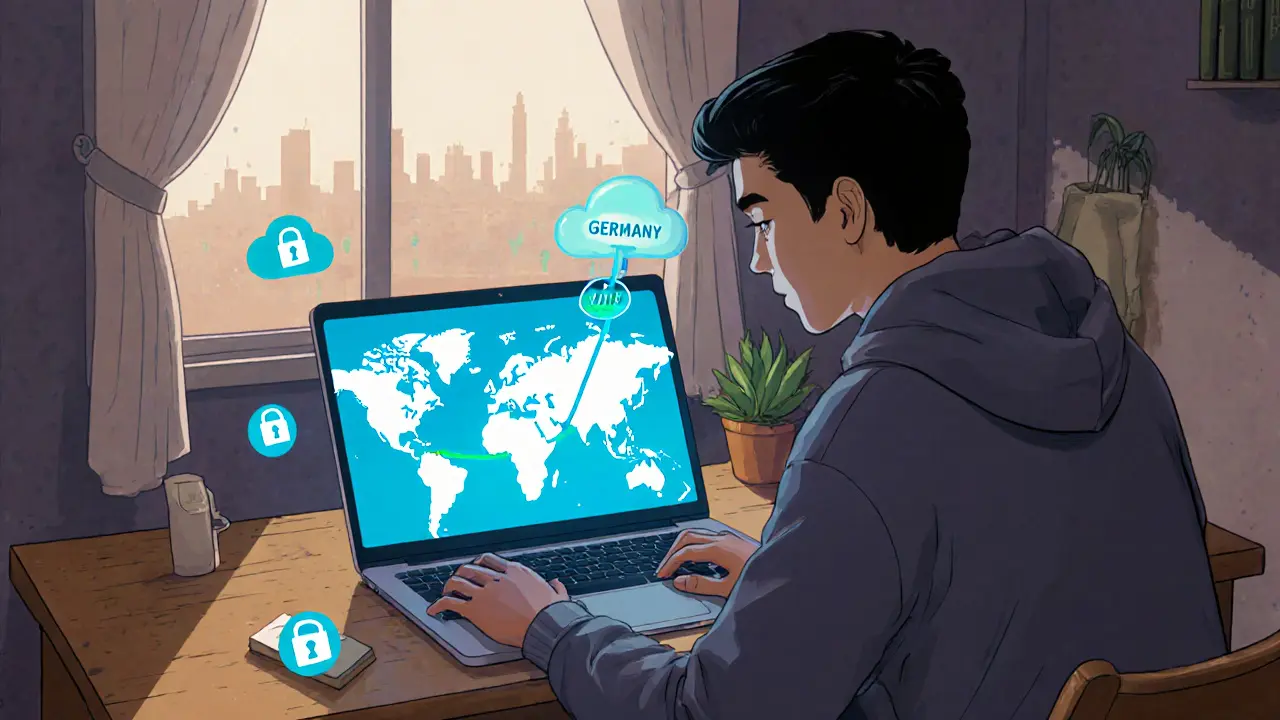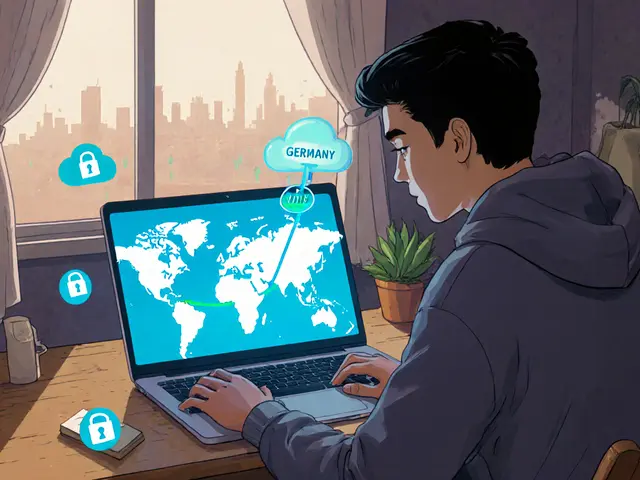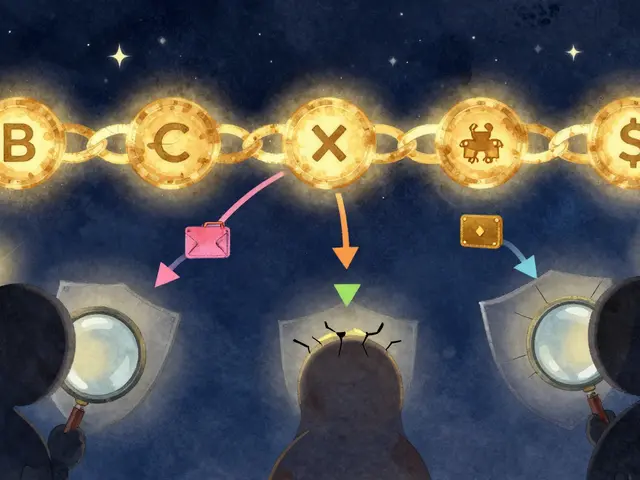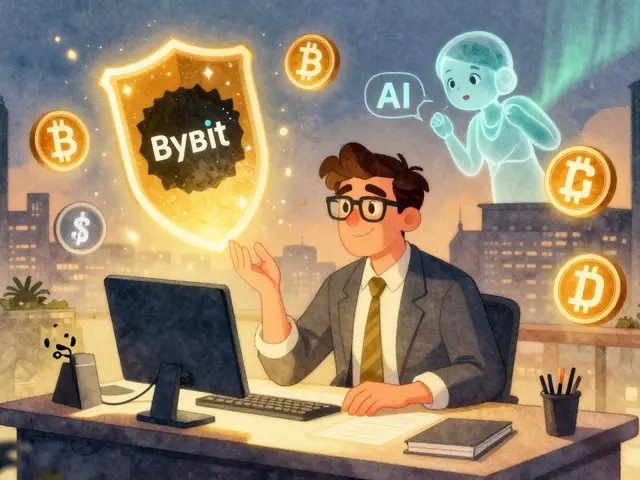VPN Risk Calculator for Iranian Traders
Risk Assessment Form
Risk Assessment Results
No risk calculated yet
Key Takeaways
- Iranian crypto traders rely on VPNs to bypass strict local bans, but detection methods have become extremely sophisticated.
- Connection drops, free‑VPN leaks, and device fingerprinting are the top ways exchanges spot Iranian users.
- Recent 2025 crackdowns froze over a million bank accounts and triggered massive volume drops on domestic exchanges.
- Underground services now bundle foreign IBANs, OTP SIMs, and fake IDs to fool KYC checks.
- Using a reputable paid VPN with a dedicated IP, a kill‑switch, and multi‑hop routing is the minimum safe setup.
Iranian crypto traders live in a constant tug‑of‑war between the need to access global markets and a government that treats digital assets as a security nightmare. The answer many turn to is a VPN a virtual private network that masks a user’s IP address and encrypts traffic. Yet, using a VPN is no longer a silver bullet. Detection systems at major exchanges now look beyond IP addresses, and the penalties for getting caught have sharpened dramatically. This guide walks through the latest risks, how they happen, and concrete steps you can take to stay one step ahead.
Why Iranian Traders Use VPNs in the First Place
The Central Bank of Iran the national monetary authority that bans domestic cryptocurrency payments prohibits most crypto‑related financial activity. At the same time, international exchanges (Binance, Coinbase, Kraken) enforce geographic blocks that lock out Iranian IPs. A VPN offers a quick workaround: route traffic through a server in a friendly jurisdiction, appear as a user from Europe or North America, and sidestep the block.
In 2024, two blockchain‑intelligence firms launched a wallet‑identification bounty targeting Nobitex Iran’s largest crypto exchange, handling roughly 87% of domestic transaction volume. The move triggered mass account freezes and forced many traders to double‑down on VPN usage, often buying full‑service packages that include foreign IBANs, OTP‑capable SIM cards, and forged residency documents.

How Exchanges Detect VPN Users
Detection is now a multi‑layered process:
- IP & Geo‑lookup: Even if a VPN claims a US IP, the exchange can query the IP’s ASN (Autonomous System Number) and see patterns that match known VPN providers.
- Device fingerprinting: Browsers leak details like screen resolution, installed fonts, and WebGL signatures. These data points create a unique fingerprint that can be compared against prior Iranian activity.
- Behavioral analytics: Timing of trades, recurring withdrawal addresses, and volume spikes linked to Iranian market hours raise red flags.
- Network drops: A brief VPN outage exposes the real IP instantly. Exchanges flag any sudden change in IP during an active session and often suspend the account.
Free VPN services add another danger layer. Many lack strong encryption and may log traffic, selling it to third parties. That data can be cross‑referenced with bank‑account seizures carried out by the Iran Cyber Police (FATA) the law‑enforcement arm responsible for cyber‑crime investigations, making a free‑VPN user an easy target.
Recent Enforcement Waves (2024‑2025)
In January2025, the Iranian authorities froze over onemillion bank accounts tied to crypto activity. The crackdown coincided with a VPN crypto Iran spike in media coverage as traders scrambled for safer routes. By June2025, crypto inflows to Iran had fallen more than 50% YoY, and July showed a 76% decline. The primary culprit?
- Enhanced detection at exchanges (especially Binance after October2021 AML upgrades).
- Targeted wallet‑identification bounties against Nobitex users.
- Cross‑agency collaboration between the Central Bank, the Ministry of Energy (which controls mining licences), and FATA.
These moves have pushed traders toward underground “circumvention packages.” Providers bundle a foreign IBAN, an OTP‑ready SIM, and a forged passport, allowing the user to pass KYC checks on overseas platforms while still routing traffic through a VPN.
Practical Steps to Reduce Detection Risk
Even with the cat‑and‑mouse game, a disciplined approach can keep your account alive. Below is a checklist you can follow before each trading session.
| Step | Action | Why It Matters |
|---|---|---|
| 1 | Choose a reputable paid VPN with a dedicated IP in a low‑risk jurisdiction (e.g., Germany, Canada). | Shared IPs are more likely to be flagged by exchange heuristics. |
| 2 | Enable the VPN’s kill‑switch and test it by disconnecting your internet while logged into the exchange. | Prevents accidental IP leaks that trigger instant suspensions. |
| 3 | Use a multi‑hop (double VPN) configuration. | Adds another layer of routing, making traffic analysis harder. |
| 4 | Pair VPN with a clean browser profile (no extensions, cleared cache, use incognito). | Reduces device fingerprint leakage. |
| 5 | Never use free or trial VPNs for real trades. | Free services often log traffic and have weak encryption. |
| 6 | Rotate IPs daily and avoid trading at peak Iranian market hours. | Breaks behavioral patterns that analytics tools track. |
| 7 | Consider using a hardware wallet and only connect to exchanges for withdrawals. | Limits the amount of on‑exchange activity that can be profiled. |
| 8 | If KYC is mandatory, use the underground identity package that provides a foreign IBAN and OTP SIM. | Legitimate‑looking documents reduce manual review triggers. |
Following the checklist doesn’t guarantee immunity, but it dramatically lowers the odds of a sudden account lock.
Alternative Strategies When VPNs Fail
When exchanges tighten their AML filters, many traders shift to decentralized exchanges (DEXs) that don’t require KYC. The TRON network, which processed over $2billion of Nobitex volume in 2025, hosts several DEXs that can be accessed via browser‑based wallets like TronLink a browser extension wallet for the TRON blockchain. These platforms still expose your IP, so a VPN is still needed, but the lack of KYC removes one detection vector.
Another emerging path is “crypto gaming” tools such as Hamster Combat a web‑based game that rewards players with cryptocurrency tokens. Because the activity resembles normal gaming traffic, it slips under many exchange monitoring systems. However, the earnings are modest and the risk of malware is higher.
Future Outlook: What’s Coming in 2026?
Blockchain‑intelligence firms are expanding bounty programs focused on Iranian wallets. Expect tighter cross‑exchange data sharing, meaning a flag on one platform can cascade to others. At the same time, advances in AI‑driven fingerprinting will allow exchanges to identify VPN users even when the IP appears clean.
For traders, the logical move is to diversify: split assets across multiple exchanges, use DEXs for a portion of the portfolio, and keep a cold‑storage stash offline. Keeping a low profile-trading smaller volumes, avoiding repetitive withdrawal addresses, and mixing in non‑Iranian transaction patterns-will become essential defensive tactics.
Frequently Asked Questions
Can I use a free VPN for crypto trading?
Free VPNs usually have weak encryption, limited bandwidth, and may log your traffic. If a free service is compromised, the logs can be handed to Iranian authorities or exchanges, leading to immediate account suspension. A paid VPN with a dedicated IP and kill‑switch is the minimum safe choice.
What happens if my VPN disconnects while I’m trading?
The exchange will see a sudden IP change from a foreign address to an Iranian one. Most platforms flag this as suspicious and suspend the account on the spot. Always enable the VPN’s kill‑switch so the internet connection cuts off before the IP leak occurs.
Do decentralized exchanges remove the need for a VPN?
DEXs don’t require KYC, but they still see your IP address. Without a VPN, you remain exposed to the same geographic blocking. Using a VPN with a DEX is still advisable, though you avoid the KYC fingerprint altogether.
How effective are underground identity packages?
When the package includes a genuine‑looking foreign IBAN, an OTP‑enabled SIM, and a forged passport, it can pass most KYC checks on major exchanges. However, exchanges are now cross‑checking withdrawal patterns and can still flag accounts if they suspect a circumvention scheme.
Is there any safe way to trade large volumes from Iran?
Large volumes attract more scrutiny. The safest approach is to break trades into smaller batches, use multiple exchanges, keep a portion of assets in a hardware wallet, and always route traffic through a premium VPN with a dedicated IP and kill‑switch. Even then, there’s no guarantee against detection.







Wayne Sternberger
October 13, 2025 AT 09:15Enabling the kill‑switch on your VPN is absolutely essential; without it a single network drop can reveal your true IP and trigger an immediate account freeze. Most premium services include a toggle that cuts all traffic the moment the tunnel fails. Test it by disconnecting your internet while logged into an exchange to confirm it works. Remember to pair the kill‑switch with a dedicated IP to avoid shared‑user fingerprints. This simple step greatly reduces the surface area for detection, even if a free‑VPN would definitelly fail.
Gautam Negi
October 14, 2025 AT 18:35The prevailing narrative that any VPN will shield Iranian traders is, frankly, an oversimplification. While encryption masks traffic, modern exchanges employ device fingerprinting that bypasses IP anonymity entirely. Moreover, the reliance on paid services fuels a market where providers hoard user data for profit. In light of these factors, traders should regard VPNs as a marginal aid rather than a panacea.
Shauna Maher
October 16, 2025 AT 03:55The state is already monitoring every packet you send; a VPN just gives them another name to look up.
Kyla MacLaren
October 17, 2025 AT 13:15I hear your concerns and agree that a multi‑hop configuration adds a valuable layer of obfuscation. Pairing that with a clean browser profile minimizes fingerprint leakage. Also, rotating your dedicated IP daily can break behavioural patterns that analytics tools rely on.
Linda Campbell
October 18, 2025 AT 22:35From a patriotic standpoint, it is imperative that Iranian traders adopt only the most robust, state‑resilient encryption tools. Utilizing a premium VPN with a dedicated IP not only safeguards personal assets but also demonstrates our collective resolve against external economic oppression. The integration of kill‑switches and multi‑hop routing embodies the spirit of technological self‑sufficiency that our nation deserves.
John Beaver
October 20, 2025 AT 07:55Multi‑hop routing essentially tunnels your traffic through two separate jurisdictions, making correlation far more challenging. When you combine this with a dedicated IP, the exchange sees a consistent endpoint that isn’t shared with other users. Be sure to enable the kill‑switch; a sudden drop otherwise exposes your home IP in seconds. Also, clear all browser caches and use an incognito window to avoid residual fingerprints.
Jazmin Duthie
October 21, 2025 AT 17:15Oh great, another VPN checklist – because nothing says "I’m safe" like copying a bullet‑point list.
Michael Grima
October 23, 2025 AT 02:35When you stare at the endless rows of risk metrics, it feels like navigating a labyrinth built by AI‑driven auditors. First, the VPN provider must be vetted for jurisdictional neutrality, because a server residing in a Five‑Eyes country automatically raises flags. Next, the encryption protocol should be OpenVPN or WireGuard; older protocols like PPTP are practically a neon sign for surveillance. Dedicated IPs act as a personal signature that prevents the "shared‑user" stigma that exchanges love to penalize. The kill‑switch isn’t just a convenience; it’s a last‑ditch lifeline that prevents a rogue packet from spilling your real address during a sudden outage. Multi‑hop routing, while adding latency, creates a two‑layered veil that confounds even the most sophisticated packet‑analysis engines. Browser hardening is equally critical – purge all extensions, disable WebGL, and spoof your user‑agent string to a generic identifier. Free VPNs should be thrown into the trash; many log traffic and even inject ads that can be traced back to you. Paid services often retain metadata for compliance, so demand a clear no‑log policy signed by a third‑party auditor. Rotate IPs daily, but avoid patterns that suggest a scripted schedule, because exchanges can map regular rotation to a user’s timezone. When you need to bypass KYC, the underground identity packages provide foreign IBANs and OTP‑enabled SIMs – but remember, these are also data points that can be cross‑referenced. Decentralized exchanges reduce KYC exposure, yet they still see your IP, so a VPN remains non‑negotiable. Finally, consider hardware wallets for cold storage; the less you interact with exchanges, the smaller your digital footprint. In sum, a layered defense – premium VPN, kill‑switch, multi‑hop, clean browser, and disciplined trading habits – is the only realistic shield against the ever‑evolving detection algorithms.
Mandy Hawks
October 24, 2025 AT 11:55Contemplating the ethical dimension, one might argue that evading state restrictions borders on moral ambiguity, yet the pursuit of financial autonomy remains a timeless philosophical quest.
Scott G
October 25, 2025 AT 21:15I understand the tension between personal liberty and regulatory compliance. While the technical safeguards you outlined are robust, it is also prudent to maintain a modest trading volume to avoid drawing undue attention. Diversifying across several exchanges can further dilute behavioural patterns that analytics engines monitor. Ultimately, a balanced approach that respects both security and prudence will serve traders best.
VEL MURUGAN
October 27, 2025 AT 06:35Analyzing the recent enforcement data, the spike in account freezes correlates strongly with the adoption of shared‑IP free VPNs. This suggests that exchanges have refined their ASN‑based detection models to flag high‑risk providers. Users should therefore prioritize services that publish transparent server inventories and regularly audit their routing tables.
Russel Sayson
October 28, 2025 AT 15:55Listen, if you keep trading with a single‑hop free VPN you are practically inviting a suspension. Upgrade to a premium, enable every security toggle, and consider a hardware wallet – that’s the only aggressive strategy that will keep you alive in this hostile environment.
Isabelle Graf
October 30, 2025 AT 01:15People need to stop romanticizing illicit workarounds; it’s just reckless.
Millsaps Crista
October 31, 2025 AT 10:35Your point about hardware wallets is spot on – they provide an offline stronghold that no VPN can replace, and they keep your assets out of the exchange’s crosshairs.
Matthew Homewood
November 1, 2025 AT 19:55In the grand tapestry of digital finance, the pursuit of anonymity becomes a dance between technology and governance, inviting reflection on the nature of privacy itself.
Shane Lunan
November 3, 2025 AT 05:15Nice insight.
Jeff Moric
November 4, 2025 AT 14:35Overall, the community should view these measures not as a guarantee but as a prudent risk‑mitigation framework. By combining a reputable VPN, dedicated IP, kill‑switch, multi‑hop routing, and a clean browser environment, traders significantly lower detection probabilities. Continual education and staying abreast of exchange policy updates remain essential, as the threat landscape evolves rapidly. Remember, diversification-both in assets and in platforms-adds an additional safety net. Stay safe, stay informed, and trade responsibly.